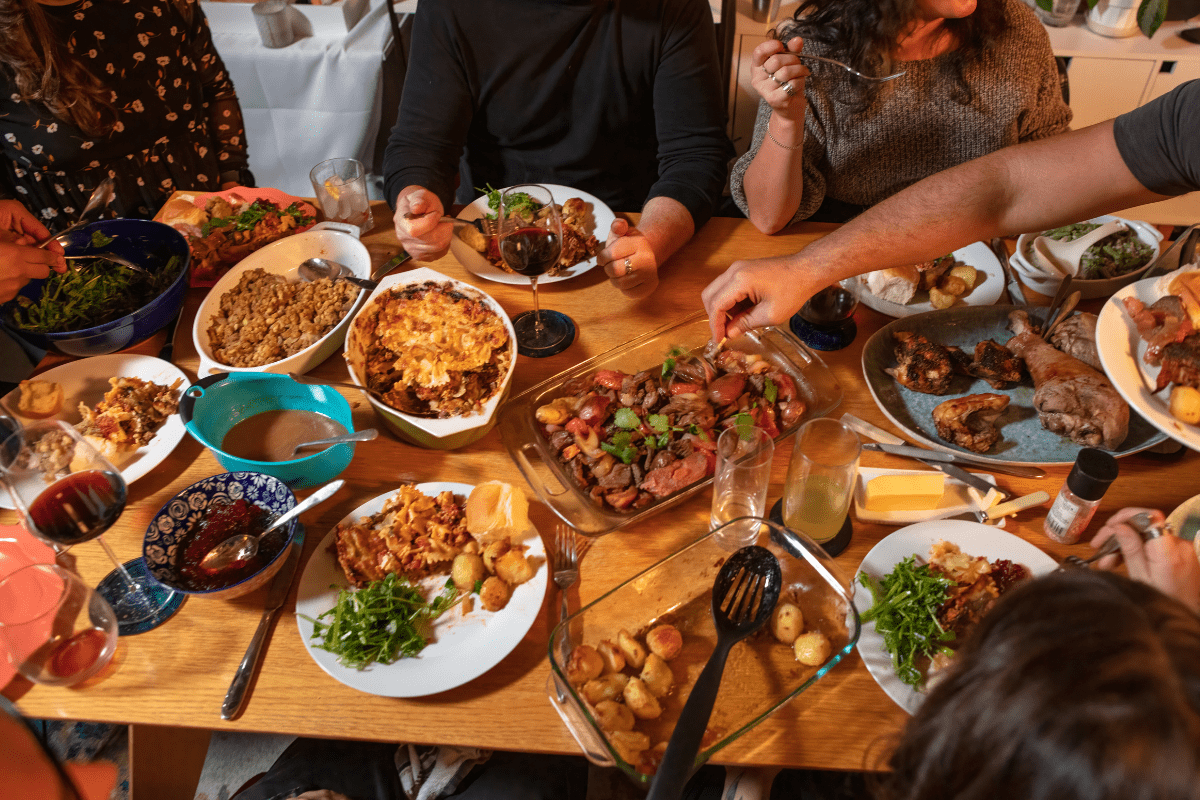Tennessee's food scene is basically what happens when three distinct culinary traditions crash into each other and decide to throw a party. You've got Cherokee agricultural wisdom, African American soul food mastery, and Scots-Irish mountain preservation techniques all mingling across 432 miles of wildly different terrain… from the Appalachian Mountains to the Mississippi River.
The Numbers Behind the Nosh
Before we dive fork-first into the good stuff, let's talk impact. Tennessee's food and beverage industry generates $5.1 billion in farm cash receipts annually. That's a lot of cornbread, y'all. Food tourism alone drives $8.4 billion in visitor spending, making up 27% of the state's massive $31.7 billion tourism economy.
With 147 million annual visitors and over 1,600 registered food manufacturers, Tennessee has evolved from agricultural powerhouse to full-blown culinary destination. But underneath all those fancy numbers lies a foundation built over centuries, where necessity shaped tradition and having very little sparked some seriously creative cooking.
Memphis: Where Greeks Taught Southerners About Barbecue
Memphis barbecue is the rebel of the Southern BBQ family. While everyone else is drowning their meat in sauce, Memphis pitmasters are over here coating their ribs in up to 40 different spices, creating a crust so perfect it needs absolutely zero liquid enhancement.
The dry rub revolution
Here's where it gets wild. The technique that makes Memphis barbecue famous came from Charlie Vergos, a Greek immigrant who basically told Southern barbecue tradition to take a hike in the 1940s. Instead of the sacred low-and-slow method, Vergos cooked his ribs directly over charcoal at 325-350°F. His fellow pitmasters probably thought he'd lost his mind.
The man positioned meat 2-3 feet below the coals and basted every 15-20 minutes with a vinegar mop infused with his secret dry rub. The typical Memphis dry rub reads like a spice cabinet explosion:
• 8 tablespoons paprika • 4 tablespoons garlic powder • 4 tablespoons mild chili powder • 3 tablespoons black pepper • Plus oregano, thyme, allspice
Baby back ribs emerged perfectly cooked in just 90 minutes. Spare ribs took 2 to 2.5 hours. The higher heat created this amazing char while the oregano and garlic gave a little Mediterranean wink to the whole operation.
Soul food and catfish dreams
Memphis's location at the Mississippi River's edge shaped way more than just its barbecue game. The surrounding Delta region, with its extensive catfish farming operations, made fried catfish a citywide obsession. And let me tell you, if you use flour instead of cornmeal for your coating, you might as well pack up and move to Ohio.
The city's soul food tradition centers on historic Beale Street, where establishments like The Four Way Restaurant (opened in 1946) served Martin Luther King Jr. his regular meals. Here, pulled pork sandwiches come with coleslaw right on top of the meat… because why dirty two plates when one will do? The sides showcase African American culinary brilliance: collard greens that have been getting cozy with ham hocks for hours, mac and cheese that uses enough cheese to make Wisconsin jealous, and cornbread baked without sugar because this is dinner, not dessert.
Nashville: The City That Weaponized Chicken
Nashville hot chicken has the best origin story in all of food history. Picture this: it's the 1930s, and Thornton Prince stays out way too late one Saturday night. His girlfriend, seeking revenge, absolutely nukes his Sunday breakfast fried chicken with enough cayenne pepper to melt steel beams. Prince's response? He asked for seconds. By mid-decade, he and his brothers had opened the BBQ Chicken Shack, turning relationship revenge into a culinary empire.
The science of suffering (deliciously)
The authentic preparation has barely changed in 90 years, which is either tradition or stubbornness… probably both. Here's how the magic happens:
First, chicken marinates in pickle juice brine for anywhere from 1 to 24 hours. Then comes the double dredge through seasoned flour and buttermilk. The breading needs to rest for 15-20 minutes to set properly before hitting the 350°F oil. But here's where things get serious: after frying, a cup of that hot oil gets mixed with cayenne pepper, paprika, garlic powder, and brown sugar, then brushed over the crispy chicken while it's still warm enough to absorb pure pain.
Heat levels range from "training wheels" (1-2 tablespoons cayenne) to the tongue-destroying "shut the cluck up" (7+ tablespoons). Traditional accompaniments remain hilariously basic: white bread to soak up the spicy oil and dill pickle chips on toothpicks because your mouth needs a fire extinguisher.
The democratic dining of meat-and-three
Nashville's other culinary institution, the meat-and-three, emerged from pure industrial practicality. In the 1930s, the May Hosiery Mill cafeteria started offering workers a simple deal: pick one meat and three vegetables with bread for 25 cents. The concept spread like kudzu throughout the city.
These aren't fancy places. You grab a tray, point at what you want, and somehow mac and cheese counts as a vegetable because Tennessee makes its own rules. Restaurants like Arnold's Country Kitchen and Swett's (opened in 1954) maintain this cafeteria-style service where strangers share tables and servers know your order before you open your mouth.
East Tennessee: Where Patience Is a Cooking Method
East Tennessee's rugged terrain basically forced people to get creative or starve. Here, Cherokee agricultural knowledge merged with Scots-Irish preservation techniques to create a cuisine defined by "hurry up and wait… for like a year."
Country ham: The marathon of meats
The region's most celebrated creation, country ham, requires the kind of commitment usually reserved for marriages or mortgages. We're talking minimum 12 months of aging. Hams cure in salt for 2.5 days per pound at 38-40°F, then age at 70-85°F until they lose 18-25% of their original weight. Unlike those fancy Virginia or North Carolina hams, Tennessee producers use the "salt box method" with heavier salt application, creating a firmer, more intensely flavored product that could probably survive nuclear winter.
Leather britches and stack cakes
The mountains' most distinctive preservation method produced leather britches beans… green beans strung on thread and hung to dry until they looked exactly like their namesake leather pants. Cooked low with salt pork for 2-3 hours, these beans develop a unique chewy texture that sustained mountain families through winters when the only fresh vegetable was whatever snow landed on your tongue.
The Appalachian stack cake served as both dessert and community builder. Wedding guests each brought a thin layer (because nothing says "congratulations" like partial cake assembly), and the bride's family provided dried apple filling. The whole thing cured for three days, allowing moisture from the apples to soften the cookie-like layers into something actually edible.
Cherokee wisdom meets modern foraging
Cherokee influence runs deep through East Tennessee cuisine. The Three Sisters planting method… corn, beans, and squash grown together… remains fundamental to regional agriculture. Ramps have been ceremonially gathered for over 12,000 years, prized for their vitamin C content and their ability to make your breath smell like a garlic factory exploded.
The tradition of foraging for pokeweed (properly called poke sallet) requires the kind of knowledge that keeps emergency rooms in business. Only young shoots can be harvested, and they must be boiled in three changes of water to remove toxins. Mess this up and you're having a very bad day. Even mushroom hunting follows Cherokee protocols, with "wishi" (chicken of the woods) remaining the holy grail of forest finds.
The Hidden Gems Nobody Talks About
Beyond the famous dishes lies a treasury of regional specialties that make Tennessee unique even among its Southern siblings.
Breakfast desserts and depression burgers
Chocolate gravy might sound like something a five-year-old invented, but this Appalachian breakfast tradition combines cocoa powder, sugar, flour, milk, and butter into a sweet sauce served over hot biscuits. Some food historians think it came through Spanish Louisiana trade networks bringing Mexican-style breakfast chocolate to the mountains. Others think mountain folks just really liked dessert for breakfast. Both are probably right.
Up in Northeast Tennessee near the Mississippi border, slugburgers offer Depression-era ingenuity at its finest. Ground beef stretched with soybean grits, deep-fried until crispy, and originally sold for a nickel (a "slug" in period slang). It's basically the culinary equivalent of making your paycheck last until Friday.
Tennessee twists on Southern classics
While chess pie appears throughout the South, Tennessee versions specifically use cornmeal as thickener rather than vinegar or buttermilk. Because if there's one thing Tennessee loves more than tradition, it's corn in literally everything.
The mountain tradition of "killed lettuce"… fresh greens wilted with hot bacon grease and vinegar… predates modern salads by roughly forever. Served when lettuce provided the first fresh vegetables of spring, it's basically salad's tougher, more practical ancestor.
Sorghum molasses production turned into community events called "stir-offs" where families processed the crop together. These gatherings preserved not just food but community bonds and the kind of traditional knowledge you can't learn from YouTube.
Modern Tennessee: Honoring Grandma While Going Viral
Contemporary Tennessee cuisine walks the tightrope between reverence for tradition and the need to Instagram everything. Nashville's hot chicken, once confined to a handful of establishments in African American neighborhoods, now appears in forms that would make Thornton Prince question reality… hot chicken sushi, anyone?
Festivals, craft beer, and whiskey dollars
During the annual Hot Chicken Week, over 35 restaurants offer $7 specials, showcasing variations that range from traditional to "what were they thinking?" The state's 141 craft breweries provide endless pairing opportunities, while Tennessee whiskey exports totaled $914 million in 2023… more than double any other state.
Modern restaurants practice "micro-seasonality," changing menus eight times annually to showcase Tennessee's agricultural diversity. Some chefs have revived nearly extinct ingredients like Jimmy Red corn and Carolina Gold rice, adapting them to Tennessee's climate. It's farm-to-table on steroids, minus the actual steroids because that would defeat the purpose.
The numbers game
The farm-to-table movement found particularly fertile ground here, where 385,743 individuals work in agriculture. That's 8.8% of state employment, which explains why your server can probably tell you the name of the chicken you're eating.
Memphis's World Championship Barbecue Cooking Contest draws 75,000 attendees annually, while newer events celebrate everything from hot chicken to ramps to sorghum. Because if Tennessee knows anything, it's how to throw a party around food.
Why Tennessee Food Stands Out
Tennessee cuisine resists simple categorization because the state itself is wonderfully complicated. From Memphis's Mississippi River blues culture to Appalachian mountain traditions, from Nashville's music industry glamour to small-town agricultural roots, Tennessee encompasses multiple Souths that somehow coexist on the same plate.
What unifies Tennessee cuisine is an approach to cooking that values time, tradition, and community over convenience. Whether dry-rubbing ribs in Memphis, properly preparing poke sallet in the mountains, or serving meat-and-three in Nashville, Tennessee cooks understand that the best flavors can't be rushed. They also understand that sometimes the best recipes come from revenge, desperation, or just making do with what you've got.
In an era of instant everything, Tennessee's culinary traditions offer something increasingly rare: food that connects us to place, history, and each other. Those 147 million annual visitors aren't just coming for the music or the mountains. They're coming for the kind of meal that tells a story with every bite… a story of survival, adaptation, and delicious innovation that could only happen here, where three food cultures met, argued a bit, then decided to create something entirely new and wonderful.





